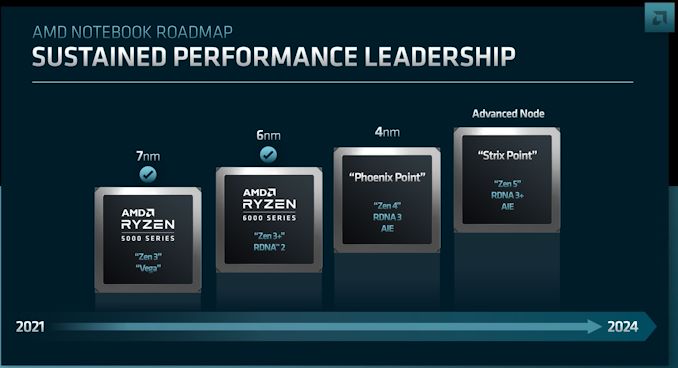Updated AMD Notebook Roadmap: Zen 4 on 4nm in 2023, Zen 5 By End of 2024
by Gavin Bonshor on June 9, 2022 6:35 PM EST
As we've come to expect during AMD's Financial Analyst Day (FAD), we usually get small announcements about big things coming in the future. This includes updated product roadmaps for different segments such as desktop, server, graphics, and mobile. In AMD's latest notebook roadmap stretching out to 2024, AMD has unveiled that its mobile Zen 4 core (Phoenix Point) will be available sometime in 2023 and Zen 5 for mobile on an unspecified node which is expected to land sometime by the end of 2024.
The updated AMD Notebook roadmap through to 2024 highlights two already available mobile processors, the Zen 3-based Ryzen 5000 series with Vega integrated graphics and the latest Ryzen 6000 based on Zen 3+ and with the newest RDNA 2 mobile graphics capabilities. But there's more that is due to be announced starting in 2023.
From The Rembrandt, Rises a Phoenix: Zen 4 Mobile AKA Phoenix Point
What's new and upcoming on the updated AMD mobile roadmap is the successor to Rembrandt (Ryzen 6000), which AMD has codenamed Phoenix Point. AMD Phoenix Point will be based on AMD's upcoming Zen 4 core architecture and will be built using TSMC's 4 nm process node. According to the roadmap, AMD's Zen 4 Phoenix Point mobile processors will use Artificial Intelligence Engine (AIE) and AMD's upcoming and next-generation RDNA 3 integrated graphics.
Also Announced: Zen 5 Mobile Codenamed Strix Point
Also on the AMD notebook roadmap is the announcement of its Zen 5-based platform on an unspecified manufacturing process, codenamed Strix Point. While details on Strix Point are minimal, AMD does state that Strix Point will use AMD's unreleased RDNA 3+ graphics technology, which will likely be a refreshed and perhaps more performance per watt efficient RDNA 3 variation.
Also listed within the slide of the roadmap with Phoenix Point and Strix Point is an Artificial Intelligence Engine (AIE), which is more commonly found in mobile phones. The AI Engine or AIE will allow AMD to spec its products based on tiling with an adaptive interconnect. Still, it hasn't unveiled much more about how it intends to incorporate AIE into its notebook portfolio. We know that it is part of AMD's XDNA Adaptive Architecture IP, which comes from its acquisition of Xilinx.
We will likely learn more about AMD's Phoenix Point based on Zen 4 in the coming future, as a release date sometime in 2023 is expected. As for Strix Point, which will be using its unannounced Zen 5 microarchitecture, we're likely to hear more about this next year sometime.












21 Comments
View All Comments
asmian - Thursday, June 9, 2022 - link
There's some continually funky spelling of "phoenix" in this article. If you want search hits maybe you should fix that. The slide has it correct...Silver5urfer - Thursday, June 9, 2022 - link
Where's that cancerous Pluton spyware chip debuted with Rembrandt. That AIE is fancy but FPGA finally ? But why debuting on a BGA machine which is use and throw and not on a beast like desktop AM5 socketed parts or EPYC series. No idea, what is their thinking here. But maybe looking for some of that dedicated compute blocks like Apple's bragging on how great ARM cores are doing X task because of the IP blocks on the silicon. Well I hope they crush ARM joke because Qcomm is trying so hard on this front, with the mobile focus MS already destroyed Windows with 11, and further mobile focus means worse computing standards. Even though BGA is inferior an x86 BGA is far better than any other due to sheer compatibility of software and a bit of DIY possibility.fmcjw - Thursday, June 9, 2022 - link
So like still 2 years behind Apple for fanless performance and form factors... what is all this focus on "performance" when 6 watt performance is already good enough for otg computing?lemurbutton - Friday, June 10, 2022 - link
I think AMD is about 6 years behind Apple in fanless performance. No way AMD can match the M1 in perf/watt until Zen6 on second gen 3nm.By then, Apple will be on M5 2nm.
sgeocla - Friday, June 10, 2022 - link
AMD already matched M1 multithreading efficiency with Zen3+ Ryzen 6800U. Since M2 is still on 5nm and Zen4 mobile Strix Point is on 4nm people will see pretty soon that aside from Apple hardware accelerated apps, AMD Zen4 mobile is going to have very similar or even better efficiency.Apple M1/M2 efficiency is all being on a newer node with much greater efficiency and much greater density which allows Apple to make very wide but slower clocking chips with large dies and transistor counts. All this means that Apple chips are way more expensive but Apple doesn't care since their customers pay more for 8GB RAM and 128GB more SSD space upgrade then average PC people pay for their whole notebook.
Apple will probably regain their efficiency crown when they move to 3nm.
t.s - Saturday, June 11, 2022 - link
Don't feed the troll.Dante Verizon - Sunday, June 12, 2022 - link
Dont waste your time talking with apple fans**sgeocla - Friday, June 10, 2022 - link
As AMD explained, the problem with fanless is not a CPU/APU problem. It's a device manufacturer problem and the costs to make such a device requires a huge price premium on the end product.Currently on Apple has the mindshare and money to create such a device and sell it for such a huge price since Apple fans don't care about the actual specs of the product and only care about its ecosystem/lifestyle aspects.
fmcjw - Friday, June 10, 2022 - link
I meant if they put an Ryzen 5 6600U in a Surface Go and down clock it to 2.4GHz, it would probably do fine for most tasks given the improved IPC. Better yet if AMD released some Rembrant-based Semprons. But it's AMD's decision to release just 3 15-watt U series SKUs that boost to 4.x GHz and aim the rest of the lineup to 28 watts and above.But yeah, it's probably a Microsoft problem because OneDrive/indexing/anti-malware just soaks up the cycles. And hardware HEVC encode/decode probably won't be leveraged for battery efficient video editing like it is on MacBooks.
lazybum131 - Tuesday, June 14, 2022 - link
Best hope for this gen would be the upcoming AMD Mendocino APU, only quad-core Zen 2 with rumoured 2CU of RDNA2, but as a cut down 6nm version of the Aerith in the Steam Deck (that has a 4-15W TDP) if there's gonna be fanless AMD systems that's what I would bet on. It's going into the Lenovo Ideapad 1 that's currently available as a 2.6lb 11.6" or 3lb 14" fanless laptops with dual core Athlon Silver 3050e.